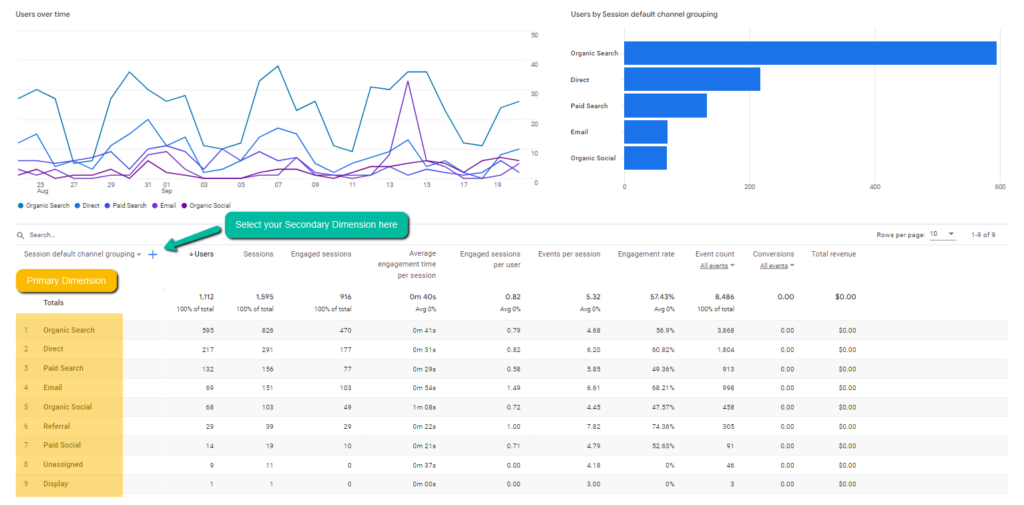Improving Data Precision: Google Analytics Secondary Dimension Insights
Improving Data Precision: Google Analytics Secondary Dimension Insights
Blog Article
Opening the Power of Secondary Dimension Analytics for Boosted Data Insights and Decision-Making
In the realm of information analytics, key measurements commonly take the spotlight, however the true deepness of insights exists within the world of additional measurements. By taking advantage of the power of additional dimension analytics, companies can introduce concealed patterns, uncover correlations, and remove a lot more significant conclusions from their data.
Relevance of Additional Dimensions
Exploring the value of additional dimensions in analytics introduces the concealed layers of data understandings vital for notified decision-making in various domain names. Additional measurements supply a deeper understanding of key data by offering added context and point of views. By incorporating additional dimensions right into analytics, organizations can remove much more thorough and nuanced insights from their datasets.
One trick significance of second dimensions is their capacity to section and categorize key data, enabling a more thorough analysis of certain subsets within a dataset. This division enables services to recognize patterns, patterns, and outliers that could not be obvious when considering the data all at once. In addition, secondary measurements aid in uncovering connections and dependences in between different variables, resulting in even more exact forecasting and predictive modeling.
Additionally, additional measurements play an important function in boosting information visualization and coverage. By including secondary dimensions to visualizations, such as graphs or graphes, analysts can produce a lot more insightful and insightful representations of data, helping with much better communication of findings to stakeholders. In general, the combination of additional dimensions in analytics contributes in unlocking the full potential of data and driving evidence-based decision-making.
Key Advantages of Making Use Of Second Measurements
Utilizing second measurements in analytics offers companies a critical advantage by augmenting the deepness and granularity of data understandings. By dissecting information using second dimensions such as time, area, tool type, or customer demographics, organizations can reveal patterns, trends, and relationships that may or else remain concealed.
Furthermore, the application of additional measurements enhances the context in which main data is translated. It gives a more thorough view of the connections in between different variables, allowing companies to make informed choices based upon a more alternative understanding of their information. Additionally, additional measurements facilitate the identification of outliers, abnormalities, and locations for optimization, ultimately resulting in extra effective techniques and enhanced end results. By leveraging secondary dimensions in analytics, organizations can harness the complete possibility of their information to drive better decision-making and accomplish their service purposes.
Advanced Information Evaluation Strategies
A deep study innovative information evaluation strategies discloses sophisticated approaches for removing beneficial understandings from intricate datasets. One such strategy is artificial intelligence, where formulas are used to recognize patterns within information, anticipate results, and make data-driven decisions. This method permits the automation of analytical model structure, making it possible for the handling of big volumes of data at a much faster rate than typical techniques.
One more advanced technique is anticipating analytics, which makes use of statistical algorithms and machine understanding strategies to forecast future outcomes based upon historic data. By assessing fads and patterns, companies can prepare for consumer habits, market trends, and possible dangers, empowering them to make aggressive decisions.
Additionally, message mining and belief analysis are beneficial methods for extracting understandings from unstructured information sources such as social networks comments, client testimonials, and study responses. By analyzing text data, companies can comprehend consumer viewpoints, identify arising trends, and improve their services or items based upon comments.
Enhancing Decision-Making Via Additional Measurements

Enhancing decision-making through additional measurements makes it possible for companies to make even more educated and targeted tactical options. For instance, by segmenting customer data based upon second dimensions like purchasing history or involvement degrees, companies can tailor their advertising approaches to specific audience sections, causing boosted conversion prices and customer complete satisfaction. Second measurements can assist determine connections and connections between different variables, making it possible for companies to make data-driven choices that drive growth and success.
Executing Secondary Dimension Analytics
When including additional measurements in analytics, organizations can open deeper understandings that drive calculated decision-making and enhance general performance. This involves understanding the certain questions the company seeks to respond to and the data points called for to address them.

In addition, organizations must leverage advanced analytics devices and technologies to improve the procedure of incorporating additional measurements. These devices can automate data processing, evaluation, and visualization, permitting organizations to concentrate on analyzing understandings as opposed to hands-on information adjustment.
Final Thought
To conclude, secondary dimension analytics play a vital duty in enhancing data insights and decision-making processes. By using innovative information analysis techniques and executing additional measurements properly, companies can open the power of their information to drive strategic company decisions. The crucial advantages of using second measurements can not be overemphasized, as they give a much deeper understanding of information fads and partnerships. It is crucial for companies to leverage secondary measurement analytics to remain affordable in today's data-driven landscape.
In great post to read the world of information analytics, main dimensions often take the limelight, yet the true depth of understandings exists within the realm of secondary measurements.Using additional dimensions in analytics supplies companies a tactical advantage by boosting the depth and granularity of data understandings. By leveraging additional dimensions in analytics, companies can harness the full possibility of their information to drive better decision-making and attain their service objectives.
Implementing information validation procedures and regular audits can aid preserve their explanation data high quality and reliability.
By making use of sophisticated information analysis techniques and carrying out secondary measurements efficiently, companies can unlock the power of their information to drive tactical organization decisions.
Report this page